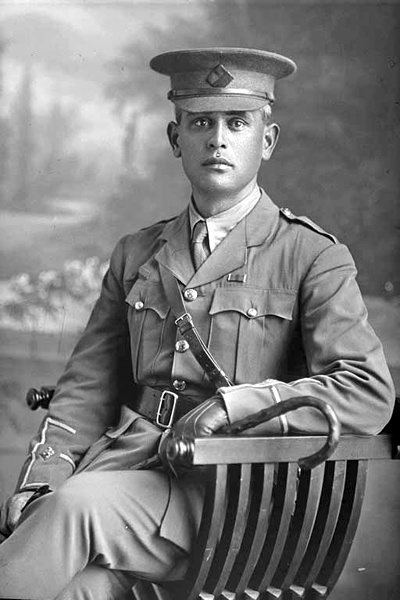
More than 2500 Māori and Pacific Islanders served overseas with the New Zealand Expeditionary Force during the First World War. More than 700 were wounded and 336 killed. One of these casualties was Second Lieutenant Hēnare Mōkena Kōhere, a highly respected officer of the Ngāti Porou tribe, who died of wounds on 16 September 1916.
Born in 1880 in Te Araroa, near the North Island’s East Cape, Hēnare was the fourth child of Hōne Hiki Kōhere and Hēnarata Pereto (Bristow), and the grandson of a Ngāti Porou chief, Mōkena Kōhere. He was educated at Kawakawa Native School in Te Araroa, and, following family tradition, Te Aute College in Hawke’s Bay.
After leaving school, Henare worked as a farm cadet on a Nelson sheep station before returning to the family farm. In 1901, he received the Royal Humane Society’s bronze medal for saving the life of a sailor whose boat had overturned. The following year Hēnare and a cousin travelled to London as Māori members of the New Zealand contingent that attended the coronation of King Edward VII. He trained and led the contingent in the haka.
On his return to New Zealand Hēnare went back to farming. In 1905, he married Ngārangi Tūrei, the daughter of the Ngāti Porou leader Mohi Tūrei. They had three children, Huinga Raupani, Ngārangi Putiputi, and Hōne Hiki.
In 1915, Hēnare followed his younger brother and enlisted for service in the New Zealand army. Before heading overseas, he wrote a letter to his children:
Ka nui te pai o nga rangi e noho atu nei. Ina tonu a Peta e noho nei kei te korero pukapuka, kei roto i taku ruma. Kia pai te noho, e hika ma, kia pai kia koutou ki to koutou tipuna hoki. Kei te pai te whanau e noho atu nei; hei te Ratapu rawa pea au nei tae ai ki te taone ki te karakia i roto i nga whare whakamiharo o te Pakeha. Kaore he korero ke atu, heoi ano ko te mahi tonu i nga mahi a te hoia. Kua tino mohio rawa te ahua o te tangata ki te mahi nei.
Hei kona ra e Hui – kia aroha ki o taina, kia pai ki a Ngarangi, a kia pai ki a Hiki. Hei Kona ra, e Hiki, tae rawa atu au kua pakeke rawa koe. Hei kona i o koutou taina, tuakana hoki; ka tata koutou te kite i a Papa. Ma te Atua tatou e tiaki e awhina, i nga wa katoa, a ka kite ano.
Heoi ano, Na to koutou papa aroha.
Papa XXXXX Ma Ngarangi e tuari nga kihi
[The weather has been good here. Peta is sitting in my room reading a book. Look after yourselves, be good to each other and be good to your Nanny. All of us are doing fine. On Sunday I’ll most probably go into town to church to one of the beautiful buildings of the Pākehā [Europeans]. There is nothing else to write about – just the usual routine of soldiers’ duties. We are getting used to this way of life.
Goodbye for now. Huinga – look after your young sister, Ngārangi, and be good to Hiki. Goodbye Hiki. When I come back you will be a big boy. Say goodbye to all your cousins and relations. It won’t be long before you see Papa again. Huinga, you and Ngārangi keep praying for Papa. The Lord support and guide us always.
Goodbye for now, from your loving Papa.
Papa XXXXX Ngārangi, you can share all the kisses to everyone.]
Hēnare reached France with the New Zealand Pioneer Battalion in April 1916. This unit worked primarily in a combat support role – clearing trees, digging trenches, building roads and other logistical tasks – and soon gained a reputation for bravery and determination. This was especially evident during the Battle of the Somme (July-November 1916) when the pioneers dug two important communication trenches – Turk Lane and Fish Alley – towards the front line under heavy shellfire.
On 14 September, Hēnare was badly wounded during a heavy artillery bombardment. Carried to his dugout, Hēnare was visited by the battalion’s second in command, Major Peter Buck. When Buck asked, ‘Kei te pehea koe, Kōhere?’ (How is it, Kōhere?), Hēnare replied, ‘Ka nui te kino’ (Things are very bad). He died of wounds two days later and was buried in Heilly Station Cemetery near the village of Mericourt-l′Abbe. At his request, the leadership of his platoon passed to another Ngāti Porou officer, Lieutenant Pekama Kaa.
Hēnare is commemorated by marae throughout Ngāti Porou’s rohe (territory). A popular waita tangi composed by Āpirana Ngata for Māori soldiers of the Pioneer Battalion refers to him by name, and images of Hēnare Kōhere and Pekama Kaa adorn the stained-glass windows of St Mary’s Anglican Church at Tikitiki.

Community contributions